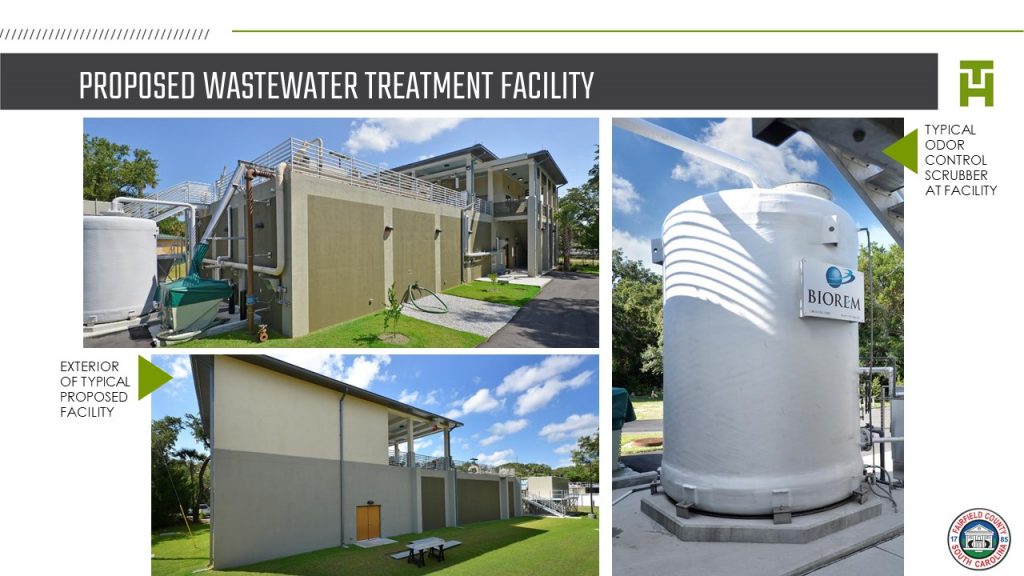
WINNSBORO – Over a hundred residents from lower Fairfield County, Cedar Creek and the northwestern section of Blythewood, including the mayor of Blythewood, filled Fairfield county council chambers and an overflow room Monday evening during a three hour council meeting over concerns about a wastewater treatment plant that council has proposed on a site near the intersection of Syrup Mill and Broom Mill Roads.
While the county has only optioned the site at this point, residents expressed concerns about the proximity of the site to their homes. Their urgency was to stop or delay the third and final reading of Ordinance 738 which many thought would finalize the purchase of the Syrup Mill Road site.
County officials said, however, that the ordinance is not for a particular parcel of land but authorizes the county to purchase at least 50 acres of land not to exceed a cost of $300,000 that would be suitable for construction of a wastewater treatment facility.
After several false starts, council approved the ordinance with a 4 – 3 vote with councilmen Moses Bell, Mikel Trapp and Douglas Pauley voting against. Pauley represents the Syrup Mill Road area.
Residents voiced their concerns during public comment time at the beginning of the meeting. But as the meeting wore on, tempers flared with frequent interruptions and outbursts from the audience. At one point chairman Neil Robinson threatened to eject those who continued to interrupt.
Addressing council, Don Quick, a resident of the Center Creek community in Ridgeway, said the big issue is the stigma attached to a wastewater plant and the effect it would have on home values in the area.
David Valentine, who also lives on Center Creek Road, said the county’s proposal would be using antiquated processes. He addressed the wastewater treatment plant as being located on an industrial site.
“Modern technology drives for a zero discharge proposal with on-site holding ponds,” Valentine said.
While many of those attending the meeting live in proximity to the plant, others who live downstream on Cedar Creek west of Blythewood in Richland County expressed concern that the plan calls for the wastewater plant to discharge treated wastewater into the creek.
“It’s bad enough that council would consider building an industrial wastewater treatment plant in the midst of this bucolic residential setting, but you would propose to flush the large toilet down Cedar Creek,” George Walker, Jr., who owns a farm in Blythewood, said.
“What guarantees do we have that this discharge water will not pollute the aquafers around and under the creek that so many families depend on?” asked Sean Goff who owns a farm on Cedar Creek. “Data shows elevated bacteria levels downstream of similar facilities. How can we let our kids play in this creek with this in place?”
Other residents addressed odors, contamination, traffic and the eyesore of the plant itself.
John Culbreth, principal/regional director of engineering firm Thomas Hutton addressed those questions as well as another 100 or so council had invited residents to send in.

With a power point presentation, Culbreth displayed what he said the facility would look like – a state-of- the-art water treatment plant recently constructed in the town of Isle of Palms.
“The type of system we’re proposing is what is being done in coastal communities where you’re dealing with property next door worth upwards of $2 million,” he said. “The one shown here is right next to a golf course.” Culbreth said the golf course uses some of the discharged water for irrigation.
“It’s nice and clean. The system is all enclosed. There are not big open aeration basins that you’re looking at. It’s not the old school stuff you see driving down I-77. That’s not what’s being built. This,” he said, pointing to the screen, “is what’s going to be built.”
“An odor scrub system will be in place, and as far as noise, sound attenuation walls on the structure will minimize pump sounds. You probably wouldn’t hear anything unless you’re on the property, and it would sound more like office type activity, nothing more than that.”
Culbreth said there will be at least 100 feet of buffer around the property and could be more if that particular sight is eventually settled on. He also said a membrane bioreactor (MBR) system, the latest technology, was chosen for its advanced level of treatment of the wastewater that will come out and because it has a small footprint.
“The system can be put inside of a facility that will look like a golf club house. It’s all inside and covered,” he said. “This is the state-of-the-art that we can do right now. It’s not your typical wastewater treatment plant. ”
Pauley asked if there was a reason the plant could not be built on the megasite.
“The issue is that the megasite is not the best site countywide,” Culbreth said. “If you’re going to try to serve just the megasite, then put it there. But the goal here is to have larger investment to the overall regional community, to benefit the overall area, and the best location for that is closer to where the site is that it benefits. And it’s the area that’s going to grow first. If the state’s going to help provide $40 million to pay for a wastewater treatment plant, it has to benefit the entire region, not just the megasite.”
While County Administrator Jason Taylor said the county has looked at other properties and that a couple of others are still in play, all of them are going to discharge into Cedar Creek.
As far as the possibility of water well contamination along the creek, Culbreth said with this type of system that will be used, he didn’t see any concerns with discharging into the creek.
“It’s septic tanks that are about five to 20 percent of the causes of any kind of well contamination,” he said. “That’s on DHEC’s website. I’ve never been asked to fix a well that was impacted.”
“Are you saying it [water discharged from the plant] won’t affect their wells?” Pauley asked.
“Yes sir, I am saying that,” Culbreth said.
“The level of treatment we’re talking about is near drinking water standards. [This discharged water] will be about as clean as the water in the creek.”




